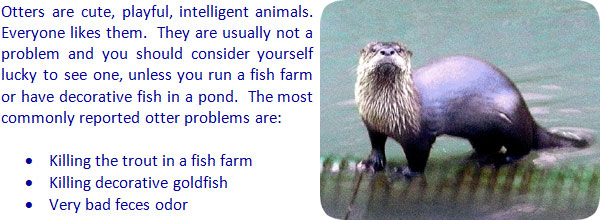- info@wildlifeanimalcontrol.com
Call us for help in your town
Wildlife Control Education
Otter Trapping - How To Trap

Need otter removal in your hometown? We service over 500 USA locations! Click here to hire us in your town and check prices - updated for year 2020.
HUMANE HINTS: In some cases, you don't need to trap or remove otters at all - you can build steel fences to keep them out of the area you don't want them.
You can even install surface fencing in water to protect fish. NEVER attempt to poison otters. Read below for how-to hints.
Otters have a sleek aquatic appearance, and they are intelligent and stealthy nocturnal and diurnal creatures. The animal’s furry coat varies in thickness depending on its habitat. It has been able to survive in many environments due to its high ability to adapt to different conditions. Unlike bears, they do not hibernate in winter; rather they may sleep for several consecutive days. Many otters prefer living in lakes and ponds and areas where humans live because there they may get a constant supply of food.
Choose the right trap
There are several traps available in the market, used to trap otters. Some of them are body grip traps paw hold traps and live cage traps. Many professional otter trappers have found that spring load and gravity traps are ideal for trapping these creatures. Gravity traps work in a way which allows you to roll the trap on its top side to release the animal. You do not need to touch the animal before releasing it. However, you should cautiously remove the animal while wearing gloves because they may bite and claw at you. Spring load traps are much bulkier than gravity traps because the doors have to be opened manually. You should always wear a glove if you want to release a otter from such a trap. Before releasing a otter, you should cover one end of the trap, so that the creature might not see you approaching.
The animal will automatically cower and hide in the covered part of the trap. This will enable you to open the door as quickly as possible so that the animal might get out. You can use cat food, fruits or corn as bait to trap the animal. The best bait to trap the animal would be fish-based foods, the best being fresh fish, then sardines. The more food you place in a trap, the higher the chances of catching a otter. After catching a otter, you should take it to a place teeming with food like near a pond or a river. If you do this, you will ensure that the animal will not come back to your home.
When trapping otters you should be cautious of those that look sickly and confused. They may be suffering from rabies, which is an extremely contagious and dangerous disease to humans.
More in-detail how-to otter removal articles:
Information about how to kill a otter - with poison or other methods.
Information about how to keep otters away - prevention techniques.
Information about how to catch a otter - remove one stuck in the house.
Information about otter repellent - analysis of types and effectiveness.
Otters may be seen around areas like ponds, lakes, garbage cans and fishponds, since they are voracious eaters, and they ingest just any food they may find in the dumpsters and garbage bins. You should always make sure to keep pet food inside the home at night, to avoid giving these creatures a free treat. They are exceptional because they have a taste for sweet food, unlike other wild animals. This makes it easier to catch otters using baited traps. Since they are active at night, they will most likely hunt for food at dusk and during the night. Otters can transmit rabies like common wild animals, so it would be practical not to touch them in case you come across them.
This site is intended to provide otter education about how to trap a otter in your house or property and and information about otter trapping, so that you can make an informed decision if you need to deal with a otter problem. This site provides many otter control articles and strategies, if you wish to attempt to solve the problem yourself. If you are unable to do so, which is likely with many cases of otter removal, please go to the home page and click the USA map, where I have wildlife removal experts listed in over 500 cites and towns, who can properly help you with your nuisance otter.
Click here to read more about how to get rid of otters.

















